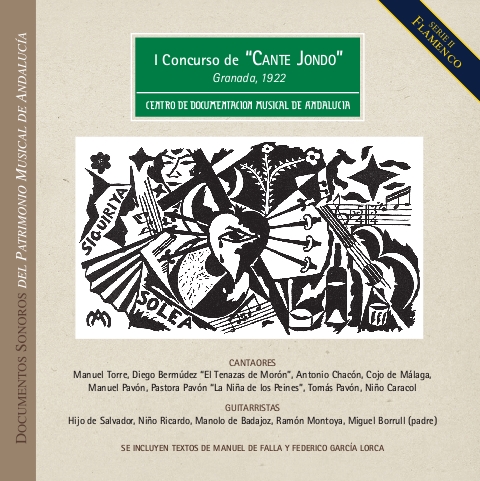I Concurso de
Detail DSF-0210 You can buy this record here 19 € I Concurso de Granada, 1922
MANUEL TORRE. Guitarra: Hijo de Salvador.
1. SIGUIRIYAS. Siempre por los rincones. (1922)
2. SOLEARES. Tan solamente a la tierra. (1922)
3. SIGUIRIYAS. Quedito los golpes. (1922)
4. SOLEARES. Yo dije que me echaría. (1922)
DIEGO BERMÚDEZ, “EL TENAZAS DE MORÓN” Guitarra: Hijo de Salvador.
5. CAÑA. En el querer no hay venganza. (1923)
6. SOLEARES. Correo de Vélez. (1923)
7. SOLEARES DE PAQUIRRI. Magino entre mí. (1923)
8. MARTINETES. Ya me sacan de la cárcel. (1923)
9. SIGUIRIYAS GITANAS DE SILVERIO. He andaito la Francia. (1923)
10. SERRANAS. Bajó llorando. (1923)
ANTONIO CHACÓN. Guitarra: Ramón Montoya.
11. MEDIA GRANAÍNA. Engarzá en oro y marfil. (1925)
RAMÓN MONTOYA. Guitarra.
12. SOLEARES EN MI. (1925)
COJO DE MÁLAGA. Guitarra: Miguel Borrull, padre.
13. GRANAÍNA DE FRASQUITO “YERBAGÜENA”. (1922)
MANUEL PAVÓN Guitarra: Ramón Montoya.
14. SEGUIDILLAS. A clavito y canela. (1920)
NIÑO CARACOL. Guitarra: Manolo de Badajoz.
15. SEGUIRIYAS. Currito. (1931)
16. SOLEARES. Si quieres que te perdone. (1931)
GRUPO GITANO “LA COJA”.
17. FANDANGOS DEL ALBAYCIN. (1931)
LA NIÑA DE LOS PEINES. Guitarra: Niño Ricardo.
18. SOLEARES. Hasta la fe del bautismo. (1928)
19. SOLEARES. Cuando se empaña un cristal. (1928)
20. SEGUIRIYAS. TuÌ no tienes la culpa. (1928)
21. PETENERA. Quisiera yo renegar. (1928)
22. ALEGRIÌAS. Yo le diÌ un duro al barquero. (1927)
23. SAETA. Ay, Pilatos. (1927)
24. SEGUIRIYA. Delante de mi mare. (1927)
25. TANGO FLAMENCO. Yo no te he dao motivos. (1927)
LA NIÑA DE LOS PEINES. Guitarra: Manolo de Badajoz.
26. BULERIÌAS. Que te he queriÌo no lo niego. (1929).
27. FIESTA GITANA. Yo he visto varios pintores. (1929).
TOMAÌS PAVOÌN. Guitarra: Niño Ricardo.
28. MEDIA GRANAIÌNA. Que la llaman la Alcazaba. (1927).
29. FANDANGUILLOS. Amapola de un trigal. (1927).
|
About There can be no doubt that the Cante Jondo contest held in Granada during the Corpus celebrations on 13 and 14 June 1922 was an important milestone in the history of flamenco, although some scholars, looking back on it from our current perspective, question the timeliness of its celebration, the organisational model and its restrictive rules. It is true that almost a century later, and having witnessed the course that flamenco has taken over this long journey, some of the premises on which the contest was based could be considered exceedingly alarmist –especially that the purest forms of cante were in imminent danger of disappearing– something that ultimately never materialised, in spite of the surprising ups and downs and changes that all forms of artistic endeavours have undergone over this period. At the same time, the restrictive divisions that the organizers of the contest established between true cante jondo and flamenco singing, as if they were two separate entities instead of interrelated disciplines, has not been sustained by their subsequent evolution. And lastly, to give just three examples, the exclusive participation of amateur singers, who in the opinion of the organisers had held on to the essence of this “art of the people”, as opposed to professional singers, who according to the organisers had been corrupted by the commercialization, popular success and influence of the copla. This prevented many great cante figures from participating in the event, many of whom had drawn upon the roots of this great, leafy tree to create new, interesting branches. One cannot really argue, as some experts have claimed, that the celebration of this contest was a watershed in the development of flamenco, but it was a kind of barometer and captured the attention of all those, intellectuals or otherwise, who considered cante jondo a marginal form of art, of little cultural interest and very much a product of the seedy world of bars: dark and sinful at the very least. In truth, and seen from our current perspective, the contest was an attempt to revitalise a type of music that was believed to be in danger. And in a way perhaps it was, when seen from within the prevailing mood of regeneration inspired by the Free Teaching Institu- te founded in 1876 –the year of Manuel de Falla’s birth– by Francisco Giner de los RiÌos, whose nephew Fernando de los RiÌos was one of the great driving forces behind this contest. De los RiÌos was a Professor of Political Law at the University of Granada, a great friend of both Lorca and Falla, and a long-established flamenco fan who was often seen at venues where there was dancing and singing, and was even said to have sung himself on occasions. Although the responsibility for organizing the event fell to the painter and sculptor Miguel CeroÌn and the Granada Art and Literature Centre directed by Antonio Ortega, Antonio Gallego BuriÌn and Francisco Vergara, the undisputed figure -head was Manuel de Falla– more, even, than Federico GarciÌa Lorca. In addition to Falla, Lorca and Fernando de los RiÌos, others who collaborated closely included Fernando ViÌlchez, the flamenco guitarist Manuel JofreÌ, Francisco Vergara, the painter RamoÌn Carazo, the engraver Hermenegildo LeoÌn and the guitarist AndreÌs Segovia. Others who added their names to the project and its wider aims included Oscar EsplaÌ, JoaquiÌn Turina, Juan RamoÌn JimeÌnez, Manuel AÌngeles OrtiÌz, RamoÌn Perez de Ayala, Adolfo Salazar, BartolomeÌ PeÌrez-Casas, TomaÌs BorraÌs, Enrique DiÌez Canedo, Hermenegildo Giner de los RiÌos, Aga Lahowska and Conrado del Campo, among others.
|

